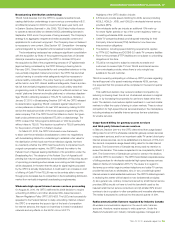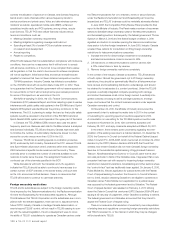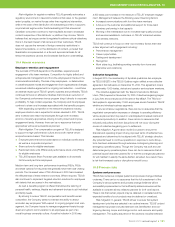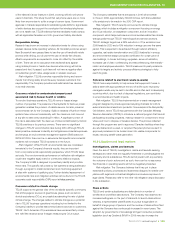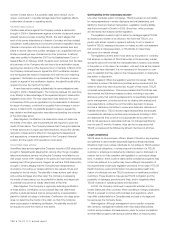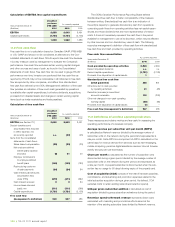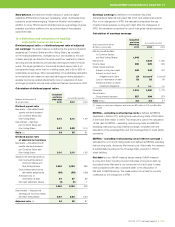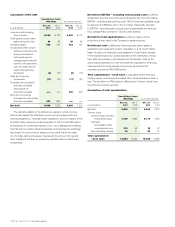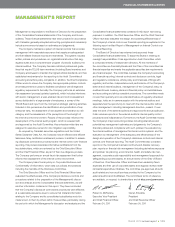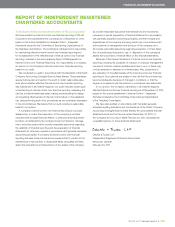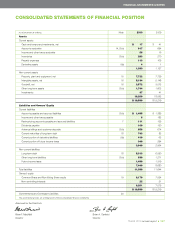Telus 2010 Annual Report Download - page 111
Download and view the complete annual report
Please find page 111 of the 2010 Telus annual report below. You can navigate through the pages in the report by either clicking on the pages listed below, or by using the keyword search tool below to find specific information within the annual report.
TELUS 2010 annual report . 107
defendants to settle claims more readily, in part to mitigate those costs.
Both of these factors may incent intellectual property rights holders
to more aggressively pursue infringement claims.
Given the vast array of technologies and systems used by TELUS
and its affiliates to deliver their products and services, and with the rapid
change and complexity of such technologies, disputes over intellectual
property and proprietary rights can reasonably be expected to increase.
As a user of technology, TELUS and its affiliates receive from time to
time communications, ranging from solicitations to demands and legal
actions, from third parties claiming ownership rights over intellectual
property used by TELUS and its affiliates and asking them to pay a settle-
ment or licensing fees for the continued use of such intellectual property.
There can be no assurance that TELUS and its affiliates will not be faced
with significant claims based on the alleged infringement of intellectual
property rights, whether such claims are based on a legitimate dispute
over the validity of the intellectual property rights or their infringement,
or whether such claims are advanced for the primary purpose of
extracting a settlement. TELUS and its affiliates may incur significant
costs in defending infringement claims, and may suffer significant
damages and lose the right to use technologies that are essential to
their operations should any infringement claim prove successful. As
developers of technology, TELUS Health Solutions and TELUS Finance
Solutions depend on their ability to protect the proprietary aspects of
their technology. The failure to do so adequately could materially affect
their business. However, policing unauthorized use of TELUS’ intellectual
property may be difficult and costly.
Risk mitigation: While TELUS and its affiliates incorporate many
technologies into their products and services, other than TELUS Health
Solutions and TELUS Finance Solutions, they are not primarily in the
business of creating or inventing technology. In acquiring products and
services from suppliers, it is the practice of TELUS and its affiliates to
seek and obtain contractual protections consistent with industry practices,
to help mitigate the risks of intellectual property infringements. It is the
practice of TELUS Health Solutions and TELUS Finance Solutions to
vigorously protect their intellectual property rights through litigation and
other means.
10.10 Human-caused and natural threats
Concerns about natural disasters and intentional
threats to TELUS’ infrastructure and its Canadian
and international business operations
TELUS is a key provider of critical communications infrastructure
in Canada and has certain supporting business functions located in
six other countries. The Company’s network, information technology,
physical assets, team members, supply chain and business results
may be materially impacted by exogenous threats, including:
.Natural disasters, seismic and severe weather-related events such
as ice, snow and wind storms, flooding, lightning strikes, wildfires,
typhoons/hurricanes, tornadoes and tsunamis
.Intentional threats such as sabotage, terrorism, labour disputes,
and political and civil unrest
.Dependence on the provision of service to the Company by other
infrastructure providers (e.g. power)
.Public health threats such as pandemics.
The Company recognizes that global climate change may exacerbate
certain of these threats, including the frequency and severity of
weather-related events.
MANAGEMENT’S DISCUSSION & ANALYSIS: 10
Since 2002, TELUS has instituted for its employees, officers and directors
an ethics policy and in 2003, established a toll-free Ethics Line for
anonymous reporting by anyone who has issues or complaints. Since
2003, TELUS has had a designated Compliance Officer, whose role
is to work across the enterprise to ensure that the business has the
appropriate controls and measurements in place to facilitate legal
compliance. For example, as a proactive measure on privacy compliance,
TELUS places a control in the project development stage of major
projects by requiring a privacy impact assessment to be performed
for all major projects involving the use of customer or team member
personal information.
In 2010, the Company continued to enhance and further test
and implement major system capabilities and processes to accommo-
date regulatory, legal and tax requirements when pursuing opportunities
outside Canada. The Company also continued to advance a program
to support TELUS’ business plans for limited additional expansion and
service extension outside Canada. In the first phase of that program,
TELUS completed its assessment of the Company’s business processes
and gating controls that strive to ensure that all foreign expansion initia-
tives receive appropriate review by regulatory, legal and taxation advisors.
Such reviews support ongoing compliance with domestic and foreign
regulatory, legal and taxation requirements. In 2010, TELUS received
proposals for the second phase to establish a mode of operation to sup-
port compliance with foreign regulatory, legal and taxation requirements.
These proposals are now under review. In addition, legal counsels
qualified in the relevant foreign jurisdictions are engaged by TELUS’
subsidiaries to provide legal advice as appropriate.
The Compliance Officer reports jointly to the Audit Committee and
the Senior Vice-President and Chief General Counsel. This dual reporting
provides direct line-of-sight reporting to the Audit Committee to address
identified risks.
Defects in software and failures in data
and transaction processing
TELUS Health Solutions and TELUS Finance Solutions provide to
their customers certain applications and managed services that involve
the processing or storing of data, including sensitive personal health
data, and the transfer of large funds. Software defects or failures in data
or transaction processing could lead to substantial damage claims.
For instance, a defect in a TELUS Health Solutions application could lead
to personal injury, while a failure in transaction processing could result
in the transfer of funds to the wrong recipient.
Risk mitigation: Management believes that it has put in place reason-
able policies, controls, processes (such as quality assurance programs
in software development procedures) and contractual arrangements
(such as disclaimers, indemnities and limitations of liability), as well as
insurance coverage, to reduce exposure to legal claims.
Intellectual property and proprietary rights
Technology evolution also brings additional legal risks and uncertainties.
The intellectual property and proprietary rights of owners and developers
of hardware, software, business processes and other technologies
may be protected under statute, such as patent, copyright and indus-
trial design legislation, or under common law, such as trade secrets.
With the growth and development of technology-based industries, the
value of these intellectual property and proprietary rights has increased.
Significant damages may be awarded in intellectual property infringe-
ment claims advanced by rights holders. In addition, defendants may incur
significant costs to defend such claims and that possibility may prompt




